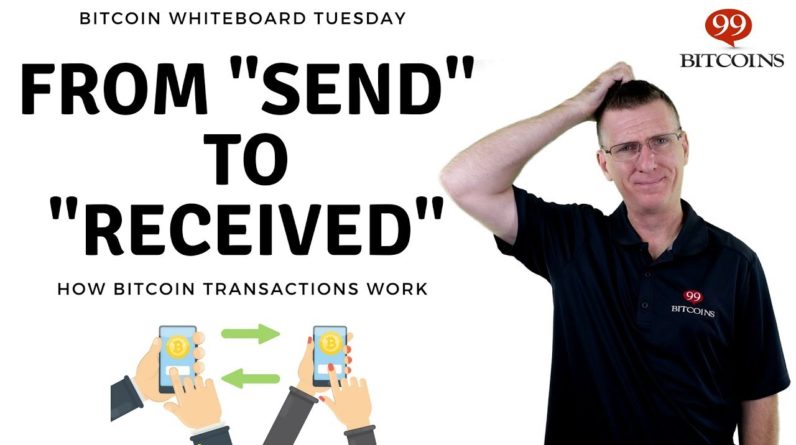
What is Bitcoin Cash? Is it the same as just “Bitcoin”? What’s the difference between the two? And which is the “true Bitcoin”? Well stick around, in this episode
of Crypto Whiteboard Tuesday we’ll answer these questions and more. Hi, I’m Nate Martin from 99Bitcoins.com and welcome
to Crypto Whiteboard Tuesday where we take complex
cryptocurrency topics, break them down and translate them
into plain English. Before we begin, don’t forget to subscribe to the channel and click the bell
so you’ll immediately get notified when a new video comes out. Today’s topic is Bitcoin Cash,
also known as BCH. The story of Bitcoin Cash goes much deeper than just
the creation of another cryptocurrency. It was actually one of the fiercest tests
for Bitcoin’s decentralization. So let’s get started… A lot of people who are just starting out
with Bitcoin or cryptocurrency in general, get confused when they see that
there’s not just one “type” of Bitcoin. For example, Bitcoin Cash, Bitcoin Gold
and Bitcoin Diamond are all forks of the original Bitcoin. A fork can be described as
an alternate version of an original coin. There are two types of forks:
soft forks and hard forks.
Soft forks are versions that work well
with both the original version and the alternate version of the coin, so as a user, you can choose which version to run
without a lot of concern. Hard forks on the other hand,
don’t play well with the original version. This means that you need to choose whether to update your software
to run the alternate version, or to stick with the original one. In other words, with hard forks, if the alternative is not accepted
by 100% of the users, then a sort of split will occur
in the network and a new coin will emerge. One that is similar to the original
but not identical. Bitcoin Cash and other Bitcoin versions are actually the results of suggested
updates to the Bitcoin protocol that weren’t agreed to by everyone.
So what happened is that
an alternate version of the coin, or a hard fork, stemming from
the original Bitcoin was created and new coins came into existence. If you want a complete detailed
explanation about forks, make sure to watch our Bitcoin Whiteboard Tuesday
Forks video as well. So now we know that Bitcoin cash
is actually a hard fork of Bitcoin, but why was it created? To answer this question,
we need to pause for a second and go back a few years to discuss
one of the most controversial topics of Bitcoin’s code –
the block size and scalability issue.
Bitcoin transactions
don’t get confirmed instantly. In order for a transaction
to be considered as confirmed it needs to be included
as part of a block of transactions on the Bitcoin ledger,
known as the blockchain. A new block of transactions
is added to the blockchain on average about every 10 minutes . Similar to any type of digital data, adding Bitcoin transactions to a block
requires storage space, and the maximum capacity
for each block of transactions is 1 MB. When you consider
the average Bitcoin transaction size, you’ll find that a block is able to hold
about 2700 transactions. 2700 transactions every 10 minutes
means 4.6 transactions a second, and that’s not a lot. Visa, for comparison, can confirm
1,700 transactions per second. This means that when a lot of people
want to send Bitcoin, during price rallies for example, transactions get stuck
in a very long queue waiting to enter a block
and get confirmed. Of course, Bitcoin allows you to pay
a higher transaction fee if you want to jump the queue, but this might cause fees
to reach ridiculous levels as more and more people try to
“cut the line” with their transactions.
This isn’t something
you want to have happen if you’re building Bitcoin to become
a global payment method. As a result of this scalability issue,
two different camps emerged. The first camp was
the “Big Blocks” camp. This camp was led by Chinese
mining giant Bitmain and Roger Ver, an early Bitcoin investor who was involved with
a number of startups when Bitcoin was just gaining
initial adoption.
Big blockers were afraid that
Bitcoin’s scalability issue would prevent it from becoming
what Satoshi Nakamoto, Bitcoin’s inventor, initially intended –
a peer to peer payment system. With such long confirmation times
and high fees, people wouldn’t use Bitcoin
for day to day transactions and would instead treat it
as a store of value – like gold. The supporters of this camp
suggested a very simple solution – Let’s increase the block size. If we increase Bitcoin’s block size to 8mb, we’ll be able to confirm as many as 8 times the number of transactions
per second.
And this will reduce
the existing congestion of the network, and in the future we’ll increase the block size
as much as needed as Bitcoin achieves further adoption. Opposing them
was the “Small Blocks” camp. The supporters of this camp rooted for
keeping the current 1mb block size, while finding solutions for optimizing
transaction size and handling, in order to enable scaling. One such solution was
Segregated Witness, or Segwit for short. Segwit is an upgrade
to the Bitcoin protocol, which among other things effectively
reduces the transaction size by 75%. This means that a 1mb Segwit block can hold the same
amount of transactions as what would be
a 4mb non-Segwit block. Additionally, Small Blockers
talked about the development of
the Lightning Network – A second layer
on top of the Bitcoin protocol that allows for instant
and feeless transactions. Now, the lightning network
is a pretty broad topic on its own, so make sure to catch
our Lightning Network episode for a detailed explanation
on how it works. But why were the small blockers
against increasing the block size to begin with? The reason is that small Blockers
believe that in the long run this would hurt Bitcoin’s decentralization
and functionality.
Here are some of the arguments
to justify their claim: For one, an 8mb or even 32mb block takes more time to travel
through the network than a 1mb block. Additionally, once the block reaches
a computer on the network, that computer now needs to verify
all of the transactions inside that block. If the block is too big it might not be able to finish
verifying all the transactions before the next block arrives
within 10 minutes or so. This means the network will start
lagging behind new transactions, which can create disputes about
the current state of the Bitcoin ledger. On top of that,
by not optimizing transactions, you’re also not optimizing
the size of the Blockchain which already takes up
several hundred Gigabytes. Forcing computers to verify
oversized transactions, reduces the number of computers
that can store the Blockchain on their hard drive, and therefore diminishes
the network’s decentralization. I mean let’s think about it for a second: If only hi-end computers that are maintained
by a handful of companies can validate transactions
on the network, we’re basically taking away
Bitcoin’s basic advantage – to have a large amount of participants to make sure
no one is breaking the rules.
To make it simple to understand,
consider this analogy: Imagine a street
that’s suffering from heavy traffic. The obvious solution would be
to increase the number of lanes, effectively the same solution
as increasing the block size. But what would you do once the street
becomes more popular and even more cars come in? Eventually, there’s a limit to
how many lanes you can add before running out of land to build it. On the other hand, you could reduce traffic congestion by promoting public transportation
routes or carpooling. Solutions similar to optimizing
the transaction size and how transactions
are handled by the network. This heated argument
between the two rival camps went on for several years
until it climaxed in August of 2017. Back then, Bitcoin was making
its first steps over the $1,200 mark and the network was getting
pretty crowded due to an overflow of transactions. As a result, many transactions got delayed
and transaction fees skyrocketed as people were outbidding each other
to “cut in line” and get confirmed faster.
The average fee around that time
was as high as $37 per transaction! Now, you may be wondering
why nobody took action to avoid this situation. Well, in order to answer this question we need to understand
who actually decides anything on the Bitcoin network. You see, Bitcoin is decentralized and this means there’s no one person
that decides anything. Participants in the network
vote through their actions. Their vote is actually whatever version
of the Bitcoin protocol they choose to run on their computer. There are several players
in the Bitcoin network. First, there are the miners
and mining pool operators. They are the ones in charge of
creating blocks and updating the ledger of transactions. Some would argue that
they have the ultimate say in what changes are finally accepted
to the Bitcoin network. Then we have the developers, which are a group of individuals
collaborating together to maintain Bitcoin’s source code. Some believe that this group
has the ultimate power since they are the ones writing
the actual code that runs the network. We also have exchanges, which are the gateways
for cryptocurrency adoption.

They can decide which version of Bitcoin
to list under the ticker symbol BTC. They’re the ones who have the power
of connecting people with the actual coins. Another important group
are the wallet providers. They write software that allows users
to manage their coins. Additionally we have the nodes, which are the different computers
which run the Bitcoin code and make sure no one
is breaking the rules. These nodes are the backbone of the Bitcoin network. Owners of the nodes can decide
to only accept transactions that support specific changes. And finally,
we have the Bitcoin users, who get to choose which coin to buy,
which exchange to use and which wallet to download. Without even knowing it,
they actually have the most power. The coin that users decide to adopt
will have the brighter future.
A good example
for the power of user adoption is the case of Ethereum’s hard fork. Back in 2016, after several million dollars were stolen
from an Ethereum based project called the DAO, the Ethereum developers suggested
rolling back the Ethereum blockchain and erasing the malicious transaction. This created a heated debate, at the end of which Ethereum
forked into two different coins – Ethereum and Ethereum Classic. However,
what’s known today as Ethereum is actually the altered Ethereum version
and not the original one. The reason that this is considered
the “true” Ethereum is because that’s the coin
most of the users decided to adopt. Miners, exchanges, wallet providers
and even developers – all rely on the acceptance of the public
to survive. That’s why in the end,
the users have the final say.
Now you understand why it’s so hard to get any change
to the Bitcoin protocol approved. You basically need to get
all of these groups to agree. Throughout Bitcoin’s history there have been several cases
were such agreements were reached, but as the network grew larger
it became harder to reach a consensus. Going back to our story in 2017, the end result of this Mexican standoff
between the two camps was that each side did what they initially
intended to do, leaving it to users to decide
which coin to adopt as the true Bitcion.
On August 1st, 2017 Small blockers activated SegWit
on the original Bitcoin protocol while big blockers created Bitcoin Cash – A Bitcoin fork with an 8mb block size. Initially it was unclear
which version of Bitcoin would win, when “Winning” in cryptocurrency terms
means having a longer blockchain, or ledger of transactions. The more miners a coin has on board
means more computational power, hence a longer blockchain
and a more robust network. Bitcoin Cash had support
from mining giant Bitmain, and as a result the original Bitcoin’s
hashing power was cut nearly in half when the fork occurred. However, when the dust settled it became clear that the original Bitcoin
was still standing strong even after the fork. Since the fork, Bitcoin Cash has consistently
maintained its space at the top of the cryptocurrency charts. The coin is backed mainly by Roger Ver, a liberterian that allegedly owns
around 100,000 Bitcoins making him one of the first
Bitcoin billionaires.
Ver also purchased the domain name
Bitcoin.com to promote Bitcoin Cash,
as opposed to Bitcoin.org, which is the website
for the original Bitcoin. Bitcoin Cash is mostly similar to Bitcoin,
but with some exceptions: First, its block size is bigger. When it first started out, Bitcoin Cash’s block size
was capped at 8mb. Later on the coin went through
another update and its block size limit
increased to 32mb. In practice, Bitcoin Cash isn’t as popular as Bitcoin and its blocks rarely surpass
1mb of transactions. Second, Bitcoin Cash
does not support SegWit or the Lightning Network. And finally, Bitcoin Cash adjusts its mining difficulty
for mining new blocks more quickly than the original Bitcoin. I won’t go into detail but it’s claimed that miners can actually manipulate this feature
to create questionable advantages. While there are additional differences
between the two coins, the ones I’ve just mentioned
are the ones that are most notable. In November 2018, Bitcoin Cash went through
its own hard fork. This time the two camps
were the original Bitcoin Cash, also known as ABC, and Bitcoin SV –
which stands for Satoshi’s Vision.
Bitcoin ABC’s camp was led by
Roger Ver and Bitmain. The Bitcoin SV camp
was led by Craig Wright – a person who previously
claimed to be Satoshi Nakamoto but never supplied ample proof, and Calvin Ayre, the owner of the largest Bitcoin Cash
mining pool, CoinGeek. There are two main differences
between the two Bitcoin Cash versions. Bitcoin ABC maintained
a maximum block size of 32mb while Bitcoin SV increased
its block size to 128mb with additional increases planned
in future updates. Additionally, Bitcoin ABC added
smart contract-like functionality into its code, while Bitcoin SV
chose not to accept this change. For now it seems that Bitcoin ABC
has become more popular and is considered by most as
the “true” Bitcoin Cash. Before we conclude
today’s extensive video I'd like to leave you with
some food for thought.
Sometimes the obvious solution
to a problem isn’t necessarily the best one. Low transaction fees are important
to the usability of Bitcoin, but not at all costs, and a quick fix often has
unforeseen consequences. I mean, just imagine
what life would be like if instead of investing in and developing
file compression technologies, we would simply have to buy
additional hard drives just to save all of our
uncompressed documents, photos, videos, and projects
to our computers. How much longer would it take
to transmit those files along the internet to our friends,
family, colleagues, or clients? Keeping this in mind, it would seem as though
optimizing data within small blocks while maintaining decentralization
will pay off in the long run. Adding to the block size
might prove necessary, but it should be used sparingly. For now,
the Bitcoin Cash hard fork saga stands as a testament to the decentralized nature
of the Bitcoin network.
It demonstrated how unbiased
the system is, and how no single party
can dictate what will happen, even when very powerful
interest groups are involved. That’s it for today’s episode
of Crypto Whiteboard Tuesday. Hopefully by now you understand
what Bitcoin Cash is – A hard fork of Bitcoin’s protocol that created a new coin
with a larger block size. You may still have some questions. If so, just leave them
in the comment section below.
And if you’re watching this video
on YouTube, and enjoy what you’ve seen,
don’t forget to hit the like button. Then make sure to subscribe
to the channel and click that bell
so that you’ll be notified as soon as we post a new episode. Thanks for watching me
here at the Whiteboard. For 99bitcoins.com, I’m Nate Martin,
and I’ll see you… in a bit..




